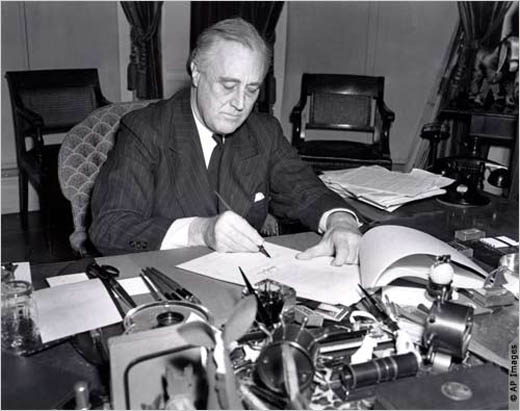Battle of the Atlantic
- U-106 sinks the British steamer Memnon (7506t) 200 miles west of Cape Blanco, French West Africa with the loss of 5 of her crew. There are 69 survivors, 22 of which make it to near Dakar. The rest land at Bathurst on 24 March.
- During the night the British steamer Trevethoe (5257t), from Convoy FS-32, is sunk by S-28 east of Orfordness with the loss of 1 on board.
The Blitz
There is a raid on Birmingham by 135 aircraft. They drop 120 tons of high explosives and 30,000 incendiaries. Some bombs land on industrial sites but many more land on built-up districts of civilian development. Extensive damage is prevented by quick responses from fire brigades. Casualties are comparatively light.
[Diplomatic Relations
The Thai-Vichy French Frontier agreement is signed aboard a Japanese warship in the Gulf of Siam. This stems from serious border clashes back in January.
[Secret War
A bomb explodes in the luggage of George Rendel, recent British Minister to Bulgaria, at a hotel in Istanbul. Rendel is unhurt, but 4 others are killed.
[United States, Politics
The Lend-Lease Bill becomes law when signed by Pres Roosevelt. It passed the House on February 8 by 260 votes to 165, and passed the Senate on March 8 by 60 to 13. Important amendments have been made by Congress. A time limit has been placed on the operation of the act - until June 1943 - but a motion originally passed in the House forbidding US warships to give convoy protection to foreign ships has been defeated. Also to be allowed are transfers of ships to other countries solely on the presidential authority without reference to Congress.
Essentially the act means that Britain can continue to order American materials without necessarily having the cash to pay for them. They are to be paid for after the war. At this stage it makes little difference to the quantity of supplies going to Britain. British war production is greater than America's and will continue to be so until some time after Pearl Harbor. Most of the items supplied for the rest of 1941 will in fact be paid for in cash. There is little difference too in the quantity supplied when compared with 1940 but in some commodities, such as food and fuel oil, the United States' contributions will be of great value.
Although justly described as one of the most generous acts of any nation's history, Lend-Lease is not entirely disinterested. Britain is compelled to go on paying cash for as long as this is possible and this means that many British assets in the US must be sold at well below their true value. Britain is also forbidden to export anything containing materials supplied under Lend-Lease nor can items wholly produced in Britain if equivalent items are being supplied under Lend-Lease. These restrictions and the keenness with which they are enforced will do much to destroy the little remains of Britain's export trade. Although there will be some relaxation of the rules in 1944, a considerable barrier will have been placed against a British postwar economic recovery.
President Roosevelt Signs the Lend-Lease Act |
 |
Yugoslavia
There are violent protests against Germany and Italy.
[